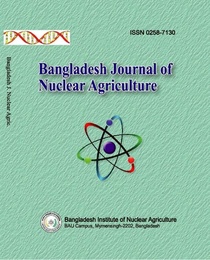PROFITABILITY AND MARKETING SYSTEM OF Binachinabadam-8 IN SOME SELECTED NORTHERN CHAR AREAS OF BANGLADESH
Abstract
The present study was undertaken to assess the profitability, marketing system, production and marketing problems of a groundnut variety, Binachinabadam-8 in the river bed areas of Rangpur, Gaibandha and Kurigram districts during 2022–23. The study analyzed the efficiency of different marketing chains by ranking performance indicators using a composite index formula. The average per hectare production cost of Binachinabadam-8 was Tk. 90,470 and the net return was Tk. 68,064. The benefit-cost ratio was estimated at 1.75 and 2.89 on a full cost and variable cost basis. The average estimated marketing cost was highest (Tk. 925/quintal) for Stockist and lowest (Tk. 87/quintal) for Arathdar. Net marketing margin was also highest (Tk. 1787/quintal) for Stockist and lowest (Tk. 115/quintal) for Arathdar. Farmer’s share in consumer prices of Binachinabadam-8 in different marketing chains was the highest in Chain-IV (65.46%) and the lowest was in Chain-I (63.98%). The performance indicators revealed that the Chain-IV was the most efficient of the chains. Farmers reported major problems including lack of irrigation facilities, high seed value, flood incidence, high fertilizer prices, lack of capital, lack of training and insect and pest. The farmers faced significant marketing challenges, including unstable prices, high transportation charges, lack of storage facilities and lack of cash capital. Therefore, the study will help to over undertake appropriate measures to overcome the production and marketing problems and thereby will increase the profitability and production of Binachinabadam-8 in the river bed areas of Bangladesh.
References
Ashley, S., Kat, K.; Hossain, A., and Nandi, S. 2000. The Chars Livelihood Assistance Scoping Study Final Report; DFID: Dhaka, Bangladesh, pp. 1–49.
BBS. 2021. Summary of Crop Statistics, Yearbook of Agricultural Statistics Bangladesh, Statistics and Informatics Division, Ministry of Planning Government of the People’s Republic of Bangladesh. Dhaka.
BBS. 2022. Summary of Crop Statistics, Yearbook of Agricultural Statistics Bangladesh, Statistics and Informatics Division, Ministry of Planning Government of the People’s Republic of Bangladesh. Dhaka.
Ferris, R.S.B., Collinson, C., Wanda, K. Jagwe, J. and Wright, P. 2001. Evaluating the marketing opportunities for shea nut and shea nut processed products in Uganda. A report prepared for USAID. pp.77.
Kohls, R.L. and Uhl, J.N. 2005. Marketing of agricultural products.9th edition. Macmillan Publishing co.,Inc., New York.
Nath, U.K. and Alam, M.S. 2002. Genetic variability, heritability and genetic advance of yield and related traits of Groundnut (Arachis hypogaea L.). Online J. Biol. Sci. 2(11): 762-764. https://doi.org/10.3923/jbs.2002.762.764
Rogers, K.G., Syvitski, J.P.M., Overeem, I., Higgins, S., and Gilligan, J.M. 2013. Farming practices and anthropogenic deltadynamics. In Deltas: Landforms, Ecosystems and Human Activities, Proceedings of the HP1, IAHS-IAPSO-IAPEI, Assembly, Gothenberg, Sweeden, 23 July 2013; IAHS Press: Wallingford, UK, pp. 133–142.
Rahman, S. 2010. Six decades of agricultural land use change in Bangladesh: Effects on crop diversity, productivity, food availability and the environment, 1948–2006. Singap. J. Trop. Geogr, (31): 245–269.
Sarker, M.H., Haque, I.; Alam, M., and Koudstaal, R. 2003. Rivers, chars and char dwellers of Bangladesh. Int. J. River Basin Manag. 1: 61–80.
Soil Resource Development Institute (SRDI) 2012. Land and Soil Resource Utilization Guide (Upazila Nirdeshika, in Bengali); Soil Resource Develop Institute (SRDI): Dhaka, Bangladesh, pp. 1–274.
-
Download



